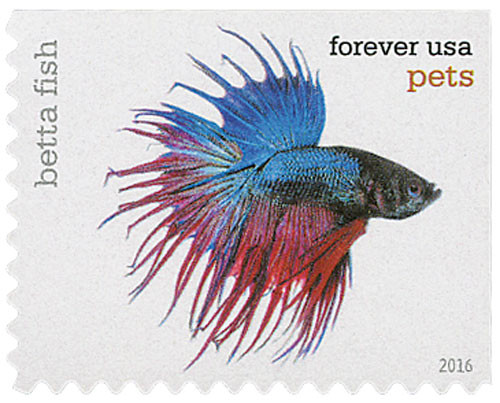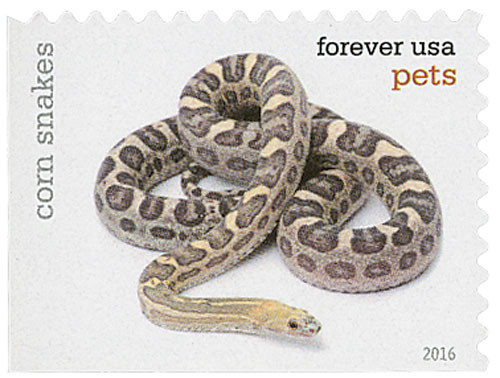
# 5115 - 2016 First-Class Forever Stamp - Pets: Parrots
US #5115
2016 Parrot – Pets
- Pictures a parrot
- Part of the 20-stamp Pets set honoring the wide range of animals we keep as companions
Stamp Category: Commemorative
Set: Pets
Value: 47¢ First Class Mail Rate (Forever)
First Day of Issue: August 2, 2016
First Day City: Las Vegas, Nevada
Quantity Issued: 400,000,000
Printed by: Ashton Potter (USA) Ltd.
Printing Method: Offset
Format: Double-sided Booklet of 20
Tagging: Nonphosphored type III, block tag
Why the stamp was issued: To celebrate the role our pet parrots play in making our lives more enjoyable.
About the stamp design: Pictures a photograph by Eric Isselée of a parrot.
First Day City: The First Day of Issue Ceremony was held at the SuperZoo National Show for Pet Retailers at the Mandalay Bay Resort in Las Vegas, Nevada.
About the Pets set: The USPS created 20 stamps to celebrate the many different animals we humans keep as companions. Each stamp pictures one species: puppies, betta fish, iguanas, hamsters, goldfish, kittens, rabbits, tortoises, guinea pigs, parrots, corn snakes, mice, hermit crabs, chinchillas, gerbils, geckos, cats, horses, parakeets, and dogs.
History the stamp represents: Playful, intelligent, and personable, parrots have long been treasured pets. But, unlike dogs and cats, pet parrots are tamed – not domesticated. The parrot family includes about 350 different species of wild birds, with a wide variety of skills and traits. Some species are quite common, while others are rare and can be expensive.
The largest parrot is the hyacinth macaw, which can reach up to 40 inches from its beak to its tail. The smallest is the pygmy parrot, which averages just over 3 inches in length. African greys are the best talkers – one owned by a London family had a vocabulary of more than 1,000 words. And the most popular is the green parrot, which is affectionate, inquisitive, and easily trained.
All parrots need socialization, crave attention, and are eager to learn. They may be slow to acclimate to a mate, but stay together once they bond. Lifespan varies with size – many large parrots can live 75 years or more.
Interestingly, parrots don’t have vocal chords. They “talk” by pushing air out of their airway like a trumpet. Parrots learn to speak best when they are excited and their trainer talks loudly and with enthusiasm – which explains why some parrots tend to learn profanity more easily than other phrases.
US #5115
2016 Parrot – Pets
- Pictures a parrot
- Part of the 20-stamp Pets set honoring the wide range of animals we keep as companions
Stamp Category: Commemorative
Set: Pets
Value: 47¢ First Class Mail Rate (Forever)
First Day of Issue: August 2, 2016
First Day City: Las Vegas, Nevada
Quantity Issued: 400,000,000
Printed by: Ashton Potter (USA) Ltd.
Printing Method: Offset
Format: Double-sided Booklet of 20
Tagging: Nonphosphored type III, block tag
Why the stamp was issued: To celebrate the role our pet parrots play in making our lives more enjoyable.
About the stamp design: Pictures a photograph by Eric Isselée of a parrot.
First Day City: The First Day of Issue Ceremony was held at the SuperZoo National Show for Pet Retailers at the Mandalay Bay Resort in Las Vegas, Nevada.
About the Pets set: The USPS created 20 stamps to celebrate the many different animals we humans keep as companions. Each stamp pictures one species: puppies, betta fish, iguanas, hamsters, goldfish, kittens, rabbits, tortoises, guinea pigs, parrots, corn snakes, mice, hermit crabs, chinchillas, gerbils, geckos, cats, horses, parakeets, and dogs.
History the stamp represents: Playful, intelligent, and personable, parrots have long been treasured pets. But, unlike dogs and cats, pet parrots are tamed – not domesticated. The parrot family includes about 350 different species of wild birds, with a wide variety of skills and traits. Some species are quite common, while others are rare and can be expensive.
The largest parrot is the hyacinth macaw, which can reach up to 40 inches from its beak to its tail. The smallest is the pygmy parrot, which averages just over 3 inches in length. African greys are the best talkers – one owned by a London family had a vocabulary of more than 1,000 words. And the most popular is the green parrot, which is affectionate, inquisitive, and easily trained.
All parrots need socialization, crave attention, and are eager to learn. They may be slow to acclimate to a mate, but stay together once they bond. Lifespan varies with size – many large parrots can live 75 years or more.
Interestingly, parrots don’t have vocal chords. They “talk” by pushing air out of their airway like a trumpet. Parrots learn to speak best when they are excited and their trainer talks loudly and with enthusiasm – which explains why some parrots tend to learn profanity more easily than other phrases.
















